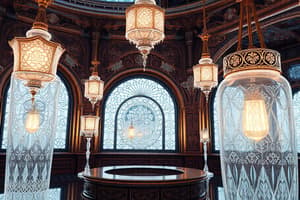Podcast
Questions and Answers
What aspect of glass is emphasized as crucial for its applications?
What aspect of glass is emphasized as crucial for its applications?
- Weight and thickness
- Robustness and safety (correct)
- Color variations
- Cost-effectiveness
Which type of glazing applications is mentioned in the overview?
Which type of glazing applications is mentioned in the overview?
- Smart glazing and acoustic glazing
- Sustainability-focused glazing and traditional glazing
- Double glazing and thermal insulation
- Vertical glazing and overhead glazing (correct)
Which theme represents the duality of glass as stated in the presentation?
Which theme represents the duality of glass as stated in the presentation?
- Visible-invisible (correct)
- Light-weight-heavy
- Ancient-modern
- Transparent-opaque
What is the significance of the case study mentioned in the lecture?
What is the significance of the case study mentioned in the lecture?
What characteristic of glass is described by the relationship between fragility and strength?
What characteristic of glass is described by the relationship between fragility and strength?
What is a key feature of float glass that contributes to its popularity?
What is a key feature of float glass that contributes to its popularity?
Which type of glass processing is prohibited after toughening?
Which type of glass processing is prohibited after toughening?
What is a limitation of rolled glass compared to float glass?
What is a limitation of rolled glass compared to float glass?
Which of the following statements regarding insulation glass is correct?
Which of the following statements regarding insulation glass is correct?
What is the primary method used for cutting glass today?
What is the primary method used for cutting glass today?
Which of the following is a characteristic of toughened glass?
Which of the following is a characteristic of toughened glass?
What describes the strength of different glass types properly?
What describes the strength of different glass types properly?
What is a characteristic of laminated safety glass?
What is a characteristic of laminated safety glass?
What is the maximum width of the Far East glass product range?
What is the maximum width of the Far East glass product range?
Which thickness tolerance applies to glass that is 10mm thick?
Which thickness tolerance applies to glass that is 10mm thick?
In the context of glass production, which characteristic is associated with high-quality mass production?
In the context of glass production, which characteristic is associated with high-quality mass production?
What is a potential arrangement of elements in a police memorial case study?
What is a potential arrangement of elements in a police memorial case study?
What is the purpose of the tension rods in the case study for the Police Memorial London?
What is the purpose of the tension rods in the case study for the Police Memorial London?
What describes the glass referred to as ‘rolled glass’?
What describes the glass referred to as ‘rolled glass’?
What texture repetition standard is used for rolled glass?
What texture repetition standard is used for rolled glass?
What is the tolerance for a 4mm thickness of float glass?
What is the tolerance for a 4mm thickness of float glass?
Which of the following is NOT a characteristic of the Super Jumbo glass product?
Which of the following is NOT a characteristic of the Super Jumbo glass product?
What type of glass is specified as ‘annealed’ in the case study?
What type of glass is specified as ‘annealed’ in the case study?
Flashcards
Glass
Glass
A transparent, brittle, inorganic material, often made from silica, that is used for various applications.
Robustness
Robustness
The ability of a material to withstand forces and deformations without breaking or failing.
Safety
Safety
A measure of how well a material can protect against injuries or harm.
Transparency
Transparency
Signup and view all the flashcards
Brittleness
Brittleness
Signup and view all the flashcards
Float Glass
Float Glass
Signup and view all the flashcards
Rolled Glass
Rolled Glass
Signup and view all the flashcards
Drawn Glass
Drawn Glass
Signup and view all the flashcards
Toughened Glass
Toughened Glass
Signup and view all the flashcards
Laminated Safety Glass
Laminated Safety Glass
Signup and view all the flashcards
Insulation Glass
Insulation Glass
Signup and view all the flashcards
Glass Cutting
Glass Cutting
Signup and view all the flashcards
Edge Working
Edge Working
Signup and view all the flashcards
Float glass thickness tolerances
Float glass thickness tolerances
Signup and view all the flashcards
Annealed glass
Annealed glass
Signup and view all the flashcards
Stacked glass
Stacked glass
Signup and view all the flashcards
Staggered arrangement
Staggered arrangement
Signup and view all the flashcards
Rotated arrangement
Rotated arrangement
Signup and view all the flashcards
Post-tensioning
Post-tensioning
Signup and view all the flashcards
Laminated/Glued stabilization
Laminated/Glued stabilization
Signup and view all the flashcards
Rolled/patterned glass
Rolled/patterned glass
Signup and view all the flashcards
Study Notes
Glass Skin Properties, Products, and Projects
- The presentation is about the properties, products, and projects related to glass skins.
- The presentation is for educational purposes at KU Leuven.
- It covers topics like introduction and history, material properties, production processes, applications, structural use, recycling, and a case study.
Overview
- Introduction & History: This section discusses the context and background of glass skin.
- Material Properties: This section delves into the attributes of the glass used in skins.
- Production & Processes: This part details the manufacturing techniques used for glass.
- Applications: This examines vertical glazing and overhead glazing and their functions.
- Structural Use of Glass: This section analyzes glass's use in structural elements.
- Recycling & Reuse: This considers the recycling and repurposing of glass products.
- Case Study: Futurium Berlin: This provides a detailed case study of the Futurium Berlin building, likely demonstrating applications of glass architecture.
Chapter 2.1 Introduction
- This chapter introduces the overall theme of the "glass skin" concept.
Visible-invisible
- The presentation uses video clips (Play Time, Jaques Tati). These clips, depicting people interacting with exterior architectural glass.
Fragile - Strong
- A video segment from True Lies, James Cameron (1994) is included, highlighting the visual contrast between the fragility and strength of glass, especially in relation to its application in architecture.
Glass and Light
- This likely shows imagery or video of glass and how it interacts with light (colour, transparency, etc.)
Glass Breaks
- This suggests a visualization of glass shattering, possibly to show its material properties under stress and potential applications in architecture.
Material Glass
- There is discussion on various types of glass: float, toughened, and laminated.
- Robustness and safety are key factors.
Principal Material Properties
- Glass is a non-metallic, inorganic material resulting from the melting of raw materials. It forms a homogenous liquid that cools without crystallization.
- Key temperatures are the working point (approx. 1040°C), softening point (approx. 720°C), and transformation temperature (approx. 530°C).
Composition Glass Recipe
- Raw materials like Silicon Dioxide (SiO2), Sodium Oxide (Na2O), Calcium Oxide (CaO), and Magnesium Oxide (MgO) form soda-lime-silicate glass (and Borosilicate glass).
Principal Physical Properties
- Density: Soda-lime-silicate glass is approximately 2.500 kg/m³, while Borosilicate glass varies from 2.200-2.500 kg/m³.
- Modulus of Elasticity: Soda-lime-silicate glass has a modulus of approximately 70,000 N/mm², while Borosilicate glass ranges from 60,000-70,000 N/mm².
- Coefficient of Thermal Expansion: Data relating to the thermal expansion of glass is given for both types.
- Thermal Conductivity: Data is provided on thermal conductivity for both glass types.
- Thermal Resistance: Approximate thermal resistance values are given.
Principal Optical Properties
- Different types of glass exhibit varying transmittance, absorption, and reflection. Float glass (white) and Borosilicate glass show different transmission properties across the light spectrum.
- Additional factors are discussed about the color and quality of the glass.
Principal Optical Properties (continued)
- Float glass can have a greenish tint due to iron oxide in the raw material.
- Extra Clear glass has a more neutral appearance due to low-iron content.
- Tinted glass results from adding metal oxides.
- Extra-clear glass often has a premium over other types and may have slower lead times.
Absorption - Body Tints
- Metal oxides affect the colors of standard float glass, leading to variations in color.
Transparency Scale
- Different levels of transparency (opaque, translucent, transparent, invisible) in glass are described and illustrated.
Reflectivity Scale
- Images illustrating mirror glass, reflective coating, clear glass, and low-reflection glass demonstrate different reflectivity levels.
Principal Mechanical Properties
- Glass is a brittle material, unlike steel.
- Statistical data about tensile strength of glass is given and it's discussed how it's different from steel.
- Glass's response to tension/compression forces is discussed.
Probability of Failure
- Statistical data on how glass's probability of strength failure varies over different durations of load, size of pane, type of glass, and environment.
Base Glass Manufacturing and Half Products
- Different types of float glass, rolled glass (patterned/wired), and drawn sheet glass are discussed.
- Key aspects of each type are highlighted.
- Manufacturing details are given for each.
Base Glass and Processing
- Data about glass quality, thickness, maximum size, and production methods are presented.
- There is information on coatings and the assembly of double glazed units.
Case Study 1: Police Memorial
- This section covers the design, materials, and construction of the Police Memorial in London (2005).
Typology Stacked Glass
- Different ways to structure glass in vertical form (vertical, staggered, rotated, post-tensioned, laminated/glued) are described and illustrated.
Vertical Dry Stack
- Details on the construction of a vertical dry stack in the Police Memorial, including the number of layers, and other structural details.
Detail
- Detailed visuals and descriptions of the technical aspects of the Police Memorial's structure.
Rolled Glass
- The attributes and applications of rolled glass are explained
Rolled Glass (continued)
- Rolled glass is discussed, including maximum size, surface properties and standard textures, colour availability, and thicknesses.
U-Channel Glass
- Dimensions and types of U-channel glass are provided
- Specific features like the thickness of the channel are given
- Manufacturers and applications of this type of glass are listed
U-Channel Glass (continued)
- Max length, types of coatings, enamel, different surface variations, and toughened/blasting applications are highlighted.
Applications
- Architectural examples using U-channel glass are presented.
Drawn Sheet Glass
- Description of drawn sheet glass and its attributes.
- Its use in architecture and construction is mentioned.
Base Glass Summary
- Overall characteristics of Float, Rolled, and Drawn types of glass.
- Dimensions, sizes, strength, cost, and usages are elaborated upon.
Glass Processing and Products
- Mechanical processing details on different glass types.
Glass Processing (Mechanical Working)
- Mechanical processes such as cutting, edging, drilling, sand blasting, and acid etching for glass are described/illustrated.
Drilling
- Different types of holes cut on glass (cylindrical, conical, undercut) are discussed.
Glass Processing (Sandblasting)
- 4 ways of producing a translucent glass effect (sand blasting, acid etching, PVB laminating, screen printing methods) are listed.
Acid Etching
- The process of acid etching, with example images, is provided..
Studying That Suits You
Use AI to generate personalized quizzes and flashcards to suit your learning preferences.




